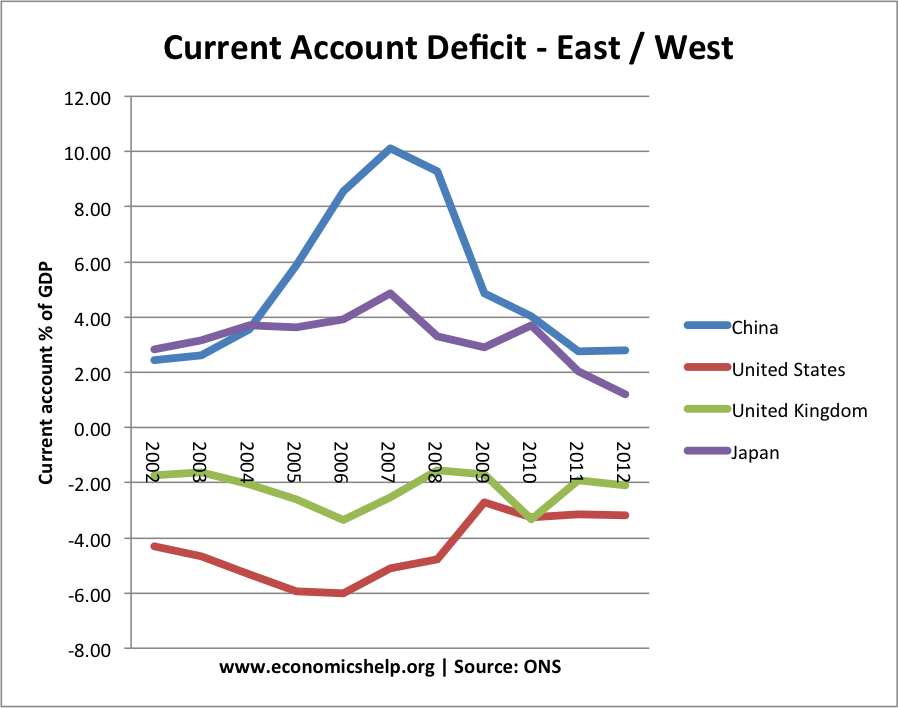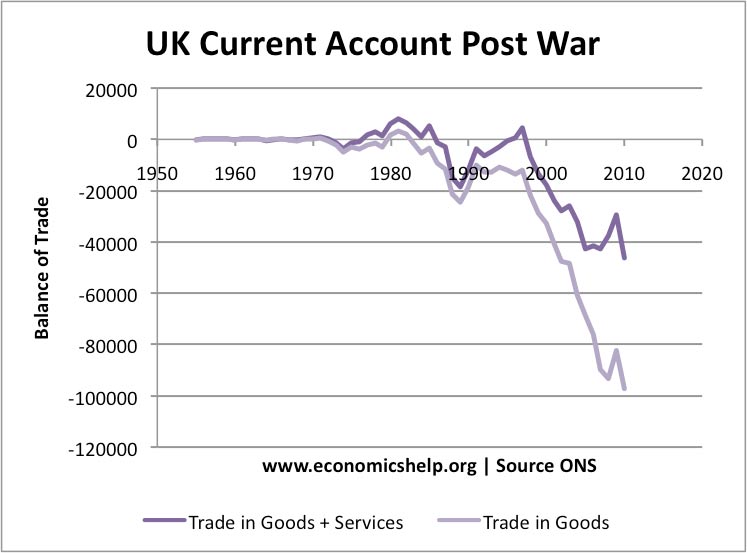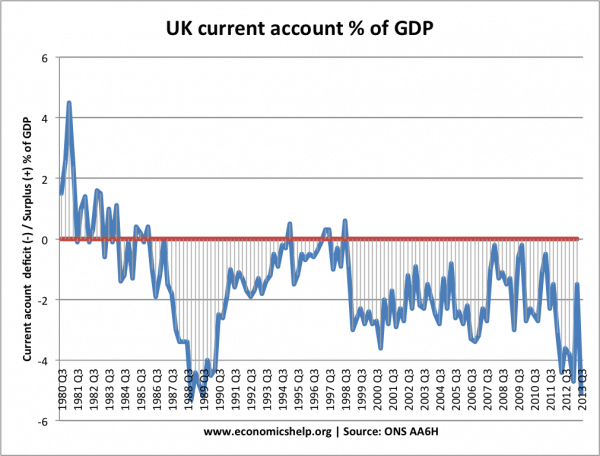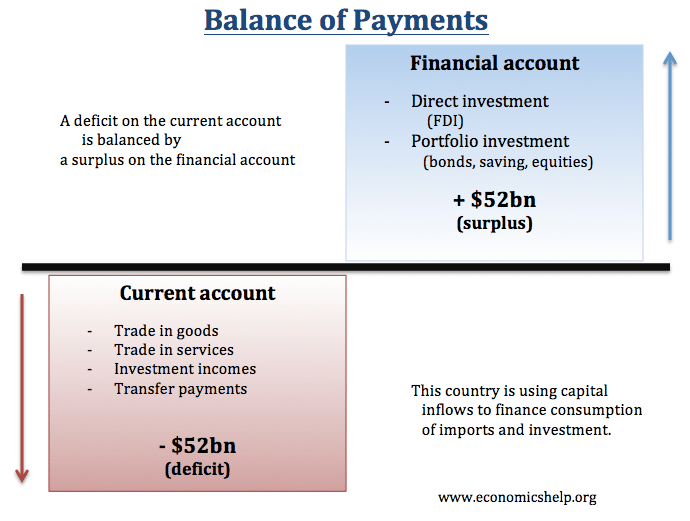Readers Question: Explain what is meant by a balance of payments disequilibrium?
The Balance of Payments is comprised of two main components:
- The Current Account (trade in goods, services + transfer payments and investment incomes)
- The Financial Account (used to be called capital account; this is capital flows such as foreign direct investment)
If the UK imports more goods and services than we export – then we have a deficit on the current account. A significant deficit on the current account is generally referred to as disequilibrium. It will be matched by a surplus on the financial account.
In the post-war period, the UK has usually had a current account deficit, apart from a brief surplus in the early 1980s and 2000s. The UK currently has a deficit on the current account.
Deficit in current account as % of GDP
See also ONS – balance of payments
Note a large surplus on the current account would also be seen as a disequilibrium. – e.g. Japan or China have large current account surplus – current account surplus

Germany’s large current account surplus was seen as an imbalance within the Eurozone – see: German current account surplus.
Note, how if one country has a large surplus on the current account (Germany). Another country will have a similar deficit. Since 2006, the US deficit with China has narrowed. Similarly, China’s surplus has fallen too.
Current account deficit suggests wider disequilibrium in the Economy
- A large current account deficit may be an indication that the economy is too much geared towards spending (e.g. spending on imports) and too little on exports. A current account deficit can occur when the saving ratio falls and domestic consumers spend more on imports.
- A current account deficit may also be a sign of underlying inflationary pressures. As domestic goods increase in price, people buy imports instead. A current account deficit often occurs towards the end of a boom – when domestic demand is rising faster than domestic supply.
- It may also be an indication the country is losing competitiveness. This is especially important in a fixed exchange rates. Southern European countries experienced record current account deficits in 2008-10 due to becoming uncompetitive within the fixed exchange rate – the Euro.
- A deficit may also be a reflection that saving is less than investment and investment is being financed by capital inflows from abroad.
Overall Equilibrium in Balance of Payments
In a floating exchange rate, the two components of the Balance of Payments should balance each other out. If the UK has a deficit on the current account of £52bn. Then in a floating exchange rate, the financial account should have a surplus of £52bn. This is because financial outflows must be matched by financial inflows.
Example, if we buy more imported goods than exported goods, then we need financial flows (e.g. hot money, long-term capital investment to finance the purchase of imports)
Balance of Payments Disequilibrium and Fixed Exchange Rates
When a country has a fixed exchange rate, there is more likely to be a balance of payments problem. For example, in 2011, several Euro countries were relatively uncompetitive. However, because they are in the Euro, it is not possible to devalue against other European countries. Therefore, they are stuck with exports which are too expensive. Therefore, we tend to see a large current account deficit.

Portugal and Greece both have a serious balance of payments disequilibrium caused by a decline in competitiveness.
Global Imbalances
A balance of payments disequilibrium can be causes of global imbalances e.g. Large flow of capital from China to the US.
Some argue this was a factor in the credit crunch of 2008. Large flows of capital from China to the US kept yields on securities and bonds artificially low, creating a bubble in certain risky assets. See: Global imbalances
The current account can also be seen as an imbalance between domestic savings and domestic investment. If domestic saving is lower than domestic investment, then we will see a current account deficit. The excess domestic investment will be financed by capital inflows from abroad. See: Current account = Saving – investment
Related




what is equilibrium & equilibrium means deficit?
what wre the consequences of bop disequilibrium to domestic and international market?
plz tell us about disequilibriumon bop
what exactly is BOP diequilibrium?
Why when the quantity supplied greater than the quantity demanded can’t be described as a surplus?
“Imbalance of payment must always balance” then why do we still have balance of payment disequilibrium. DISCUSS EXTENSIVELY
help me solve the question
if balance of payment must all be balance while then do will still have balance of payment disequilibrium? support your answer with diagram and graph
the trends in the indias balance of payment position .what are the reason for disequilibrium in the balance of payment
methods to overcome balance of payment disequilibrium in economics?
the trends in the indias balance of payment position .what are the reason for disequilibrium in the balance of payment
what are the different methods of calculating the balance of payment and the derivation of there formulars.
In what sense can a balance of payment be in equilibrium and in what sense will it always balance
Who is maintaining this Balance Of Payment ? How do u come to know if u want to c the Deficit or Surplus in the Balance of Payment ?
it is to eazy to calculate gdp and understand economics
what are the factors affecting balance of payment in Nigeria